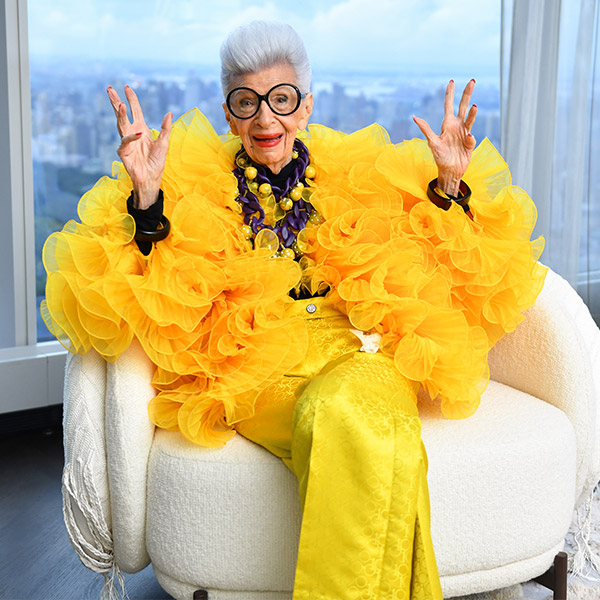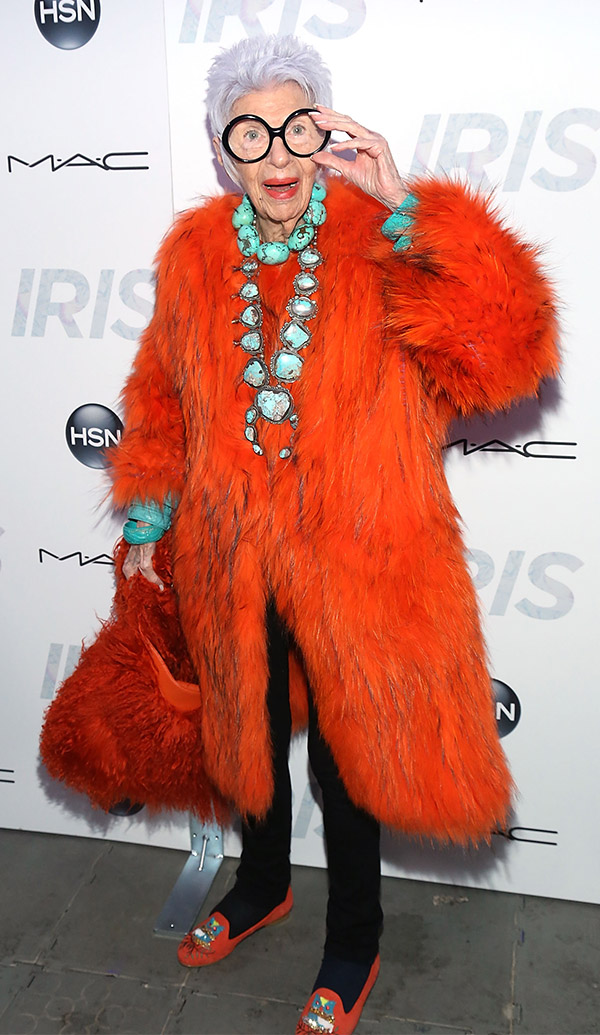
Iris Apfel, a celebrated personality known for her maximalist, wildly colorful, and electric-meets-eclectic taste in fashion and accessories, died at the age of 102 on March 2 at her home in Palm Beach, Fla.
Born in Queens, NY, Apfel began her career in the 1950s as an interior designer; later she founded Old World Weavers, a business specializing in selling and restoring textiles, with her husband, Carl. Apfel herself personally consulted on design restoration projects at the White House under nine different presidential administrations, from Truman through Clinton.
The noted jewelry sales and branding consultant Russell Pagliughi was close friends with Apfel for more than a decade and tells JCK that he remembers a trip he took with her to Newport, R.I., where they toured the town’s famous mansions.
“We went on a private tour of the Elms, the Breakers, Marble House, and Rough Point, the home of Doris Duke,” says Pagliughi. “What was fascinating was that in every home we visited, Iris would say, ‘That’s my fabric. Oh, I did that fabric.’ She worked for Doris Duke many times.”
Pagliughi met Apfel at Atelier Swarovski when he was director of sales for the brand’s North America division under Nadia Swarovski. Apfel asked his opinion of a bracelet they were reviewing for her jewelry collaboration with Swarovski, and she and Pagliughi were in agreement that it wasn’t up to snuff, not quite right.
“After the meeting she asked me to walk her downstairs to the lobby, and we went out to grab her a taxi and she said, ‘You know what? I think we’re going to be friends.’ And she invited me to dinner at her apartment that night.”
He would go on to accompany Apfel at speaking engagements all over the world and share intimate dinners with her at her apartment and favorite NYC restaurants.
“She used to call me pussycat and was like a second mother to me,” he says.
As recently as a few months ago, Pagliughi had lunch with Apfel with his husband and her beloved caregivers at a house she was renting in Sagaponack in the Hamptons.
“She was not physically good, but her appetite and her brain was sharp as a tack,” he says. “Her appetite was something I’d never seen before in all my years with her. She could eat!”
Pagliughi once attended a personal appearance with Apfel at Reinhold Jewelers in San Juan, Puerto Rico. “They had to get stanchions and shut down the store and call security because there were so many people wanting to meet her,” he says. “And at Holt Renfrew in Toronto, there were lines of people down the escalators and almost out the door.
“She wasn’t an old woman, she was a contemporary,” he says. “Anywhere we went, teenagers would run up to her asking for her autograph or to take a picture with her.”
Apfel was a fixture of New York society, but she was not a conformist—most profiles of her mention her mixing of colors, textures, and patterns. Her approach to dressing was pleasingly discordant, occasionally jolie laide, but always inventive. “More is more and less is a bore” was one of her most quotable chestnuts.
Her ascent on the New York fashion scene began in the 1990s and probably achieved its apex in 2005, when the Metropolitan Museum of Art’s Costume Institute mounted “Rara Avis: Selections From the Iris Apfel Collection.” The exhibit’s 82 ensembles and 300 accessories told a story of “ornate bohemianism” and celebrated the unique artistry of an individual who assembles her wardrobe with wild abandon but a keen eye, informed by nothing but whim and personal taste. The fashion world’s stage had a new darling. She was 84 years old.
Robert D. McFadden’s obituary of Apfel in the New York Times quoted Harold Koda, the Metropolitan Museum of Art curator who worked on the “Rara Avis” show: “To dress this way, there has to be an educated visual sense. It takes courage. I keep thinking, Don’t attempt this at home.”

Apfel’s signature look had two key elements: Oversize, owl-like eyeglasses and wrists full of bangles (Bakelite, bejeweled, and everything in between).
“I loved all the massive bracelets that she would put on—one and then another and another and another, and they’d be all the way up to her elbow,” says Pagliughi.
“No one before or since has worn jewelry like Iris Apfel did,” says Emili Vesilind, editor-in-chief of Gem + Jewel (and former JCK senior editor). “She achieved her famously maximalist style by piling on voluminous jewelry. She didn’t care what something cost—thrift-store bracelets and earrings were just fine—because she had a knack for innovative self-styling and could make cheap baubles look luxury. She taught us all how to ‘stack’ jewelry, how to mix jewelry eras and styles, and most importantly how to dress with unabashed joy.”
The 2014 documentary Iris celebrated and explored her style and helped cement her cultural icon status. Fashion insiders had known about her for decades, but now she was a household name.
Given the bold costume pieces she tended to favor, “she was clearly messaging her fearless personality,” says Marion Fasel, founder and editorial director of The Adventurine. Fasel remembers being seated at the same table as Apfel at the Accessories Council Excellence Awards in 2021. Apfel was among those being honored at the event. Some winners didn’t attend because of the pandemic, but not Apfel—100 years old at the time—who walked the red carpet in an aquamarine jacquard-weave evening suit from her then-forthcoming collaboration with H&M (with glasses to match).
“Iris stayed all night. While she gave her acceptance speech from the table, it was the most original and funny of everyone’s the entire night,” recalls Fasel, who says she places Apfel’s legacy “in the ballpark of someone like Nancy Cunard, who found a way to express her bravado at all times with piles of bangles, not to mention big bead necklaces.”
In 2011, Apfel debuted an eponymous line on the Home Shopping Network. A sought-after business partner, she lent her creative vision to a number of projects—jewelry-focused collaborations included Bernardaud and the Australian brand Erstwilder. Apfel also starred in a campaign for jeweler Alexis Bittar and sold jewelry from her personal collection on One Kings Lane.
Pagliughi says his favorite piece of hers was “a magnificent huge yellow bird”: a vintage jewel that could double as a pin or a pendant on a necklace and was a hodgepodge of wood, ceramic, and feathers. “I will always remember her loving and wearing that piece,” he says. “Trying to attach that to her probably needed 55 people, but I was always the lucky/unlucky one to do so if she wanted to wear it when we were doing something.”
As for Apfel’s influence, Pagliughi believes those who love jewelry and accessories will look to his dear friend’s example when deciding if what they are wearing is too much, or too outré, for the occasion.
“I think that when people go into the jewelry box, they’re going to add a few more bangles, a few more rings, or a few more necklaces. And that’s because of her.”
Top: Iris Apfel sits for a portrait during her 100th birthday party at Central Park Tower on Sept. 9, 2021, in New York City. (Photo: Noam Galai/Getty Images for Central Park Tower)
- Subscribe to the JCK News Daily
- Subscribe to the JCK Special Report
- Follow JCK on Instagram: @jckmagazine
- Follow JCK on X: @jckmagazine
- Follow JCK on Facebook: @jckmagazine







